Several species of grouse inhabit my backyard (Wrangell/St. Elias National Park and Preserve), Alaska. Above, sharp-tailed grouse.
video link below: Grouse in my backyard

Several species of grouse inhabit my backyard (Wrangell/St. Elias National Park and Preserve), Alaska. Above, sharp-tailed grouse.
video link below: Grouse in my backyard
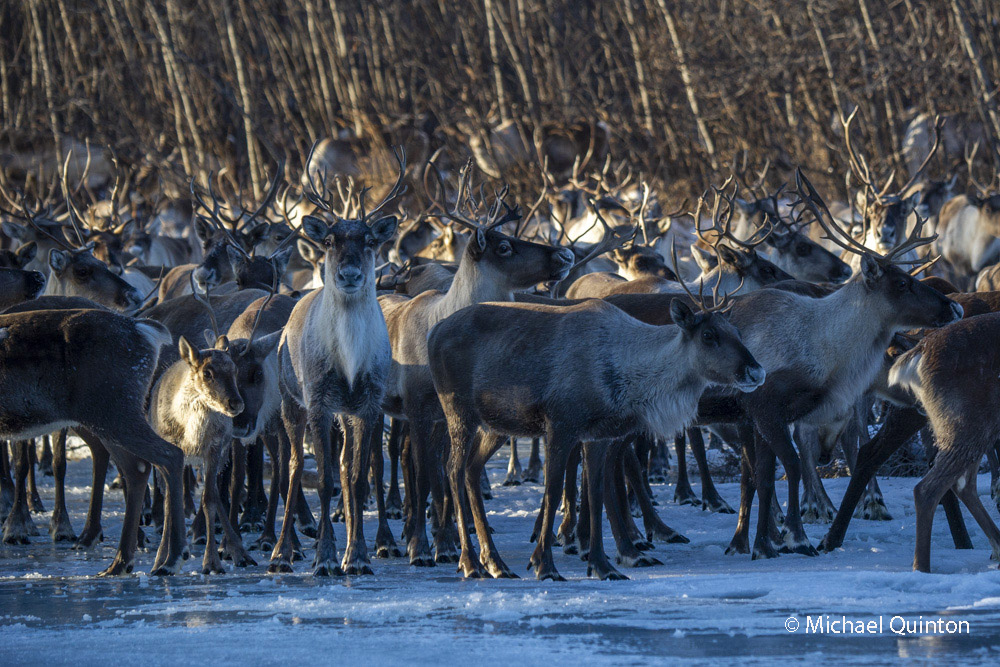 For two weeks I’d waited along this frozen river in the hopes of photographing the semi-annual caribou migration. Altogether I saw about two hundred caribou, a mere trickle compared to some years. One large group (above) had close to one hundred fifty caribou and the remaining stragglers were in pairs or small groups. The bulk had passed to the west of here earlier.
For two weeks I’d waited along this frozen river in the hopes of photographing the semi-annual caribou migration. Altogether I saw about two hundred caribou, a mere trickle compared to some years. One large group (above) had close to one hundred fifty caribou and the remaining stragglers were in pairs or small groups. The bulk had passed to the west of here earlier.
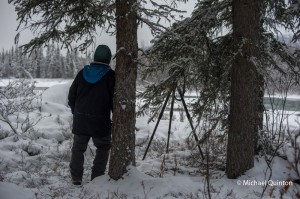 I knew from past migrations that the freezing rivers naturally funnel the caribou to this big bend in the Copper River Basin. The river, frozen on both sides, was still open in most places down the middle. I had located four likely places on the big bend where caribou had crossed, places with enough cover for a photo ambush. I moved between my ambush points to stay warm and pack down the trail between them so I could quickly move from one to another. On most days I saw no caribou. Though painfully slow, action could come at any moment.
I knew from past migrations that the freezing rivers naturally funnel the caribou to this big bend in the Copper River Basin. The river, frozen on both sides, was still open in most places down the middle. I had located four likely places on the big bend where caribou had crossed, places with enough cover for a photo ambush. I moved between my ambush points to stay warm and pack down the trail between them so I could quickly move from one to another. On most days I saw no caribou. Though painfully slow, action could come at any moment.
And when caribou are suddenly bearing down on my hide, I start forgetting things. Things like warm cabin and cold feet. And exactly, what is it I’m supposed to be doing with the camera? Luckily symptoms of buck fever are temporary.
 Of course more often than not the caribou would decide to cross where I wasn’t. With tripod and camera over my shoulder I hurried down my trail trying to stay in camera range. Out of time and breath, I planted the tripod like a mono-pod into the snow and clicked away as they plunged in and swam across.
Of course more often than not the caribou would decide to cross where I wasn’t. With tripod and camera over my shoulder I hurried down my trail trying to stay in camera range. Out of time and breath, I planted the tripod like a mono-pod into the snow and clicked away as they plunged in and swam across.
When I first noticed the caribou calf, it was in the river being carried past me by the current. He managed to climb onto an ice island in the middle of the river. After a couple of minutes he struggled to stand. Even though exhausted, the six month old calf, separated from his mom and in maximum migration mode, was pressed by the urge to keep going. Walking to the edge of the ice he stepped in with a plop and swam across the ten feet of open water but did not attempt to climb out. Instead he turned back to the island, climbed out, laid down and curled up. I stayed hidden knowing if he saw me now he might panic. The calf was in trouble and travel would wait. A rest and recharge now could only help tip the balance in his favor. Half an hour later the six month-old calf was still asleep on the ice. As I slowly moved away and headed home, I had a hunch this young caribou was a survivor.
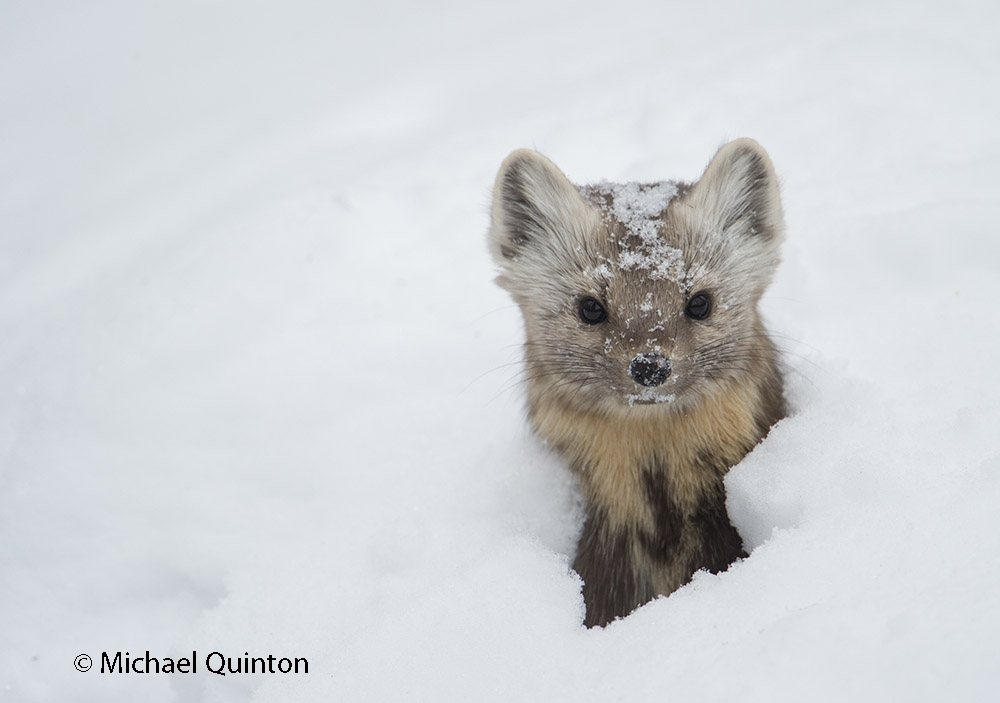 A marten pokes up through the snow to look around.
A marten pokes up through the snow to look around.
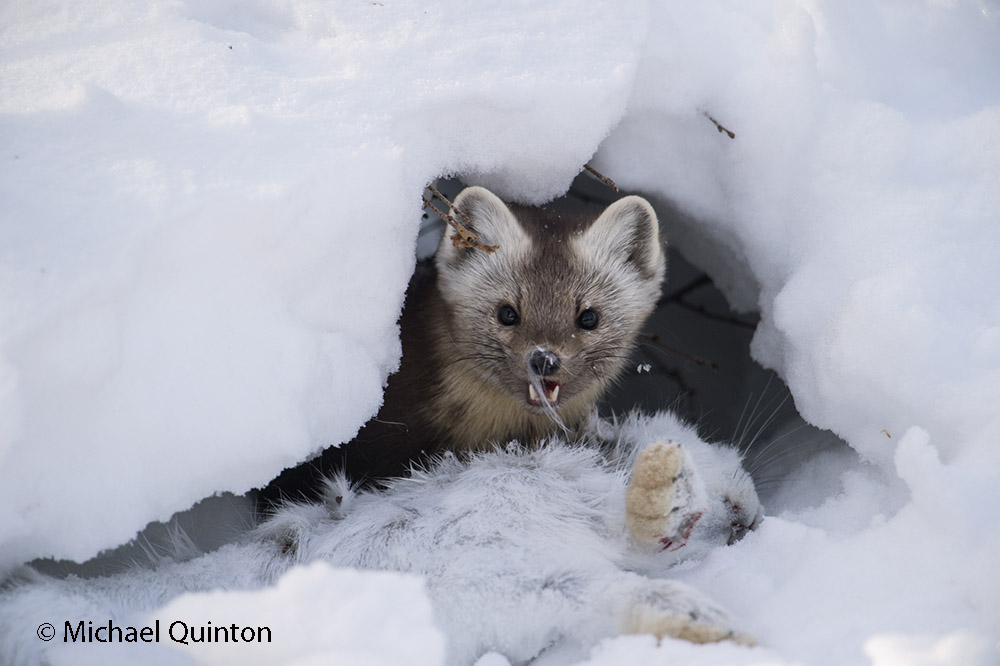 The shy and careful weasel, not liking to be exposed, has pulled its prey, a snowshoe hare, into deep snow.
The shy and careful weasel, not liking to be exposed, has pulled its prey, a snowshoe hare, into deep snow.
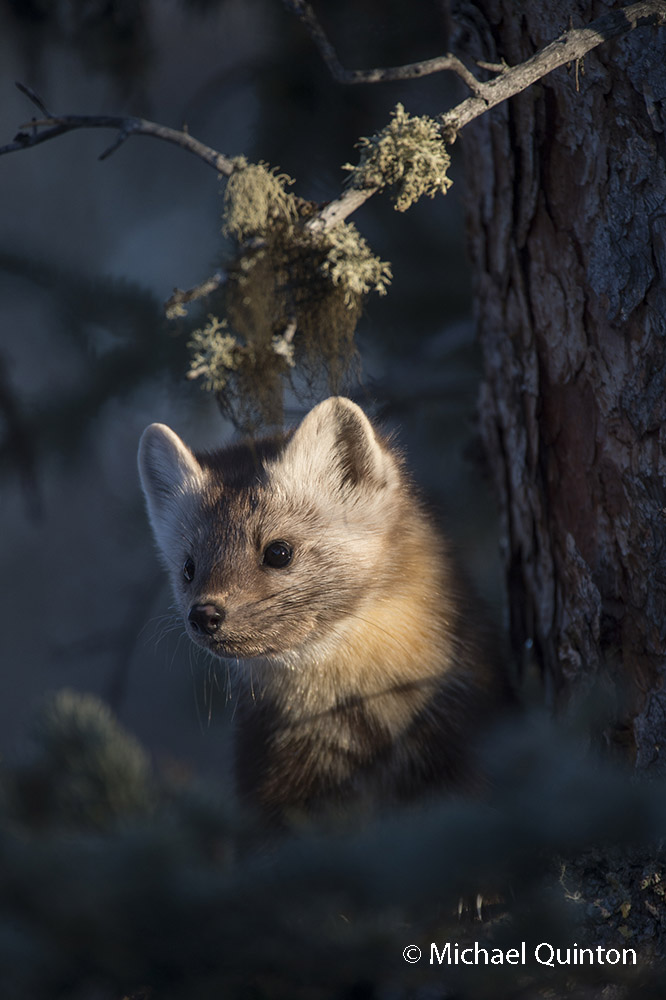 Though I have gone several years between marten sightings in the past, i typically have one or two sightings a year. But, just last week we had a marten hanging out at our place for several days. The forest around our home was laced with its familiar tracks and all the trails seemed to begin at a big wood pile like spokes of a wheel. We saw it several times daily and I was able to take hundreds of photographs of the usually elusive predator. From our front row seat at the window, we watched as the marten climbed up a spruce to a red squirrel nest and stole goodies the squirrel had stashed there. And, once I watched as it chased a snowshoe hare through the black spruce. It managed an amazing burst of speed and very nearly caught up to the hare. But when pressed the hare showed he is even quicker So, I was a bit surprised to look out the window and see the marten tugging and pulling at a hare it had caught during the night. It pulled the hare into the deep snow where it could butcher its prey concealed from the prying eyes of other predator and scavengers. First the marten gnawed off the hares head and cached it in the wood pile. The next day it cached the hares front legs. Cindy and I watched as the solitary marten entertained itself by running an obstacle course around and through the wood pile then roll on its back in the snow.
Though I have gone several years between marten sightings in the past, i typically have one or two sightings a year. But, just last week we had a marten hanging out at our place for several days. The forest around our home was laced with its familiar tracks and all the trails seemed to begin at a big wood pile like spokes of a wheel. We saw it several times daily and I was able to take hundreds of photographs of the usually elusive predator. From our front row seat at the window, we watched as the marten climbed up a spruce to a red squirrel nest and stole goodies the squirrel had stashed there. And, once I watched as it chased a snowshoe hare through the black spruce. It managed an amazing burst of speed and very nearly caught up to the hare. But when pressed the hare showed he is even quicker So, I was a bit surprised to look out the window and see the marten tugging and pulling at a hare it had caught during the night. It pulled the hare into the deep snow where it could butcher its prey concealed from the prying eyes of other predator and scavengers. First the marten gnawed off the hares head and cached it in the wood pile. The next day it cached the hares front legs. Cindy and I watched as the solitary marten entertained itself by running an obstacle course around and through the wood pile then roll on its back in the snow.
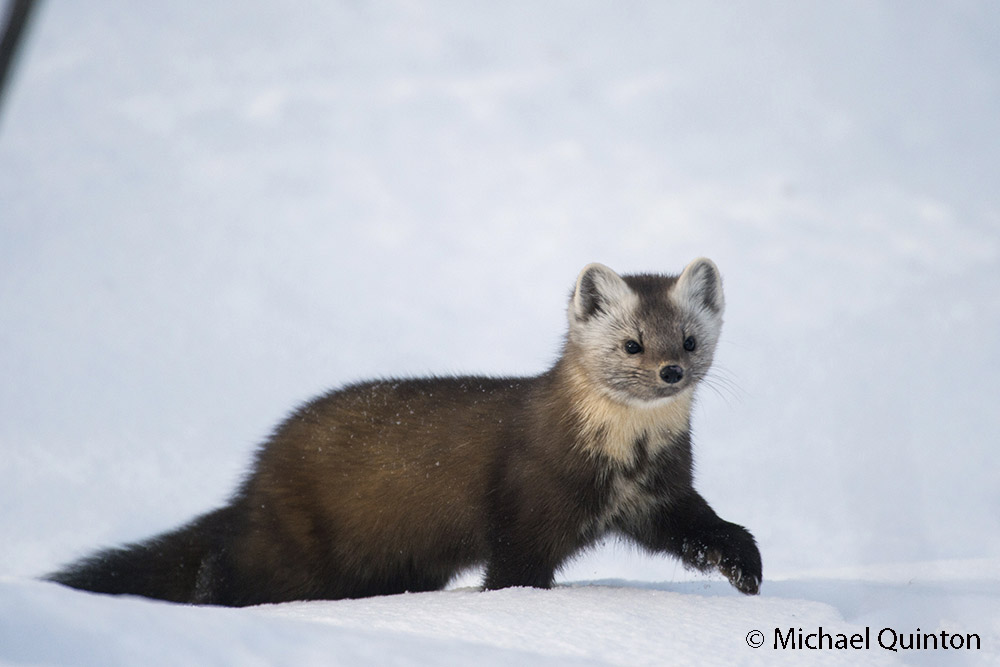 Though half the snowshoe hare was still left I spent the next two days watching and waiting for it to reappear. But just like it appeared, it disappeared. A pair of gray jays began to work the hare carcass hauling if away piece by piece, stashing it among the black spruce boughs. A pair of ravens wanted their share but only stared. For ravens, of course, are very cautious, even fearing their own food. But ravens are keen spies and watched carefully where the gray jays cached their loads. A hawk owl made a lightning quick chase and near miss of one of the gray jays. And later, I saw it swoop quickly again in the vicinity of the snowshoe hare carcass. Thinking it might have caught the gray jay I approached with my camera and telephoto lens. But the hawk owl had not caught the jay, instead it stood on the snowshoe hare carcass tugging. From the thick spruce nearby I heard a second hawk owl calling. It was the begging call of a female. After several minutes of biting and pulling the hawk owl, presumably a male, managed to tear off a chunk of the hare. It flew to a spruce and was soon joined by the female who took the offering.
Though half the snowshoe hare was still left I spent the next two days watching and waiting for it to reappear. But just like it appeared, it disappeared. A pair of gray jays began to work the hare carcass hauling if away piece by piece, stashing it among the black spruce boughs. A pair of ravens wanted their share but only stared. For ravens, of course, are very cautious, even fearing their own food. But ravens are keen spies and watched carefully where the gray jays cached their loads. A hawk owl made a lightning quick chase and near miss of one of the gray jays. And later, I saw it swoop quickly again in the vicinity of the snowshoe hare carcass. Thinking it might have caught the gray jay I approached with my camera and telephoto lens. But the hawk owl had not caught the jay, instead it stood on the snowshoe hare carcass tugging. From the thick spruce nearby I heard a second hawk owl calling. It was the begging call of a female. After several minutes of biting and pulling the hawk owl, presumably a male, managed to tear off a chunk of the hare. It flew to a spruce and was soon joined by the female who took the offering.
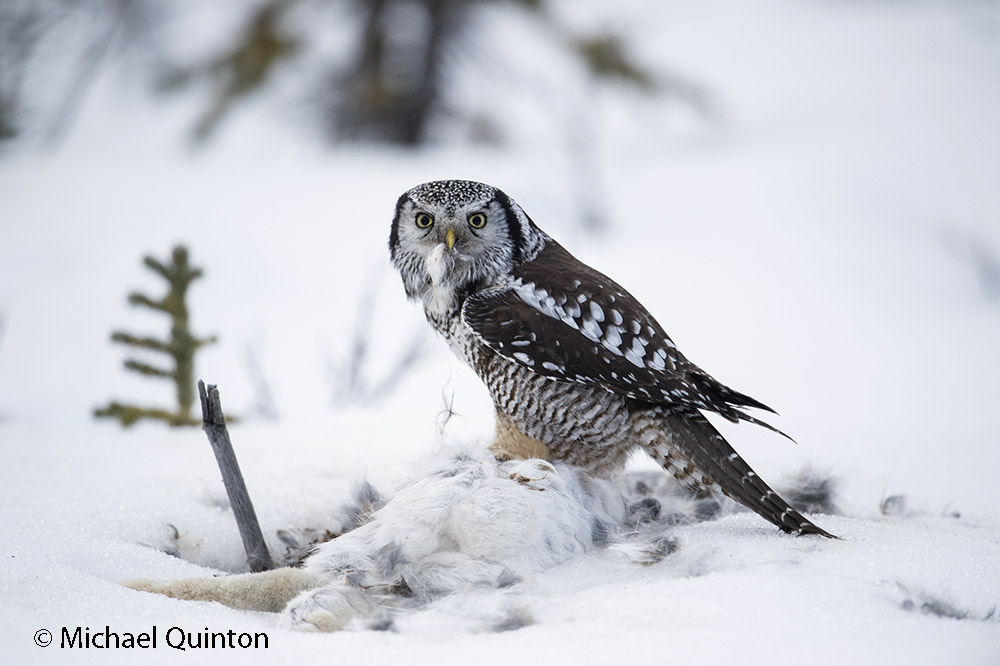 Northern hawk owl continues the butchering process of the marten’s kill. Though It is true that a predator may not use all of its prey, nothing is wasted.
Northern hawk owl continues the butchering process of the marten’s kill. Though It is true that a predator may not use all of its prey, nothing is wasted.
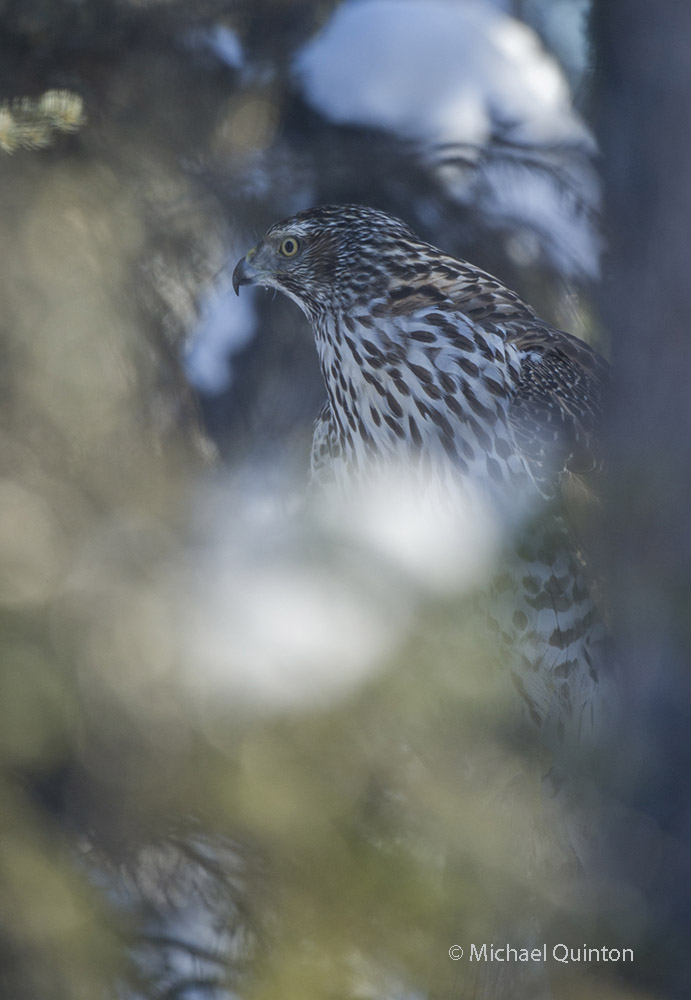 From a perch in a stand of stunted black spruce, a well camouflaged immature northern goshawk stalks its prey. Their short, wide wings and long tail give it both speed and manoeuverability to pursue prey in the forest. No small bird or mammal is safe from a sudden ambush, but this winter the large accipiters key on snowshoe hares.
From a perch in a stand of stunted black spruce, a well camouflaged immature northern goshawk stalks its prey. Their short, wide wings and long tail give it both speed and manoeuverability to pursue prey in the forest. No small bird or mammal is safe from a sudden ambush, but this winter the large accipiters key on snowshoe hares.
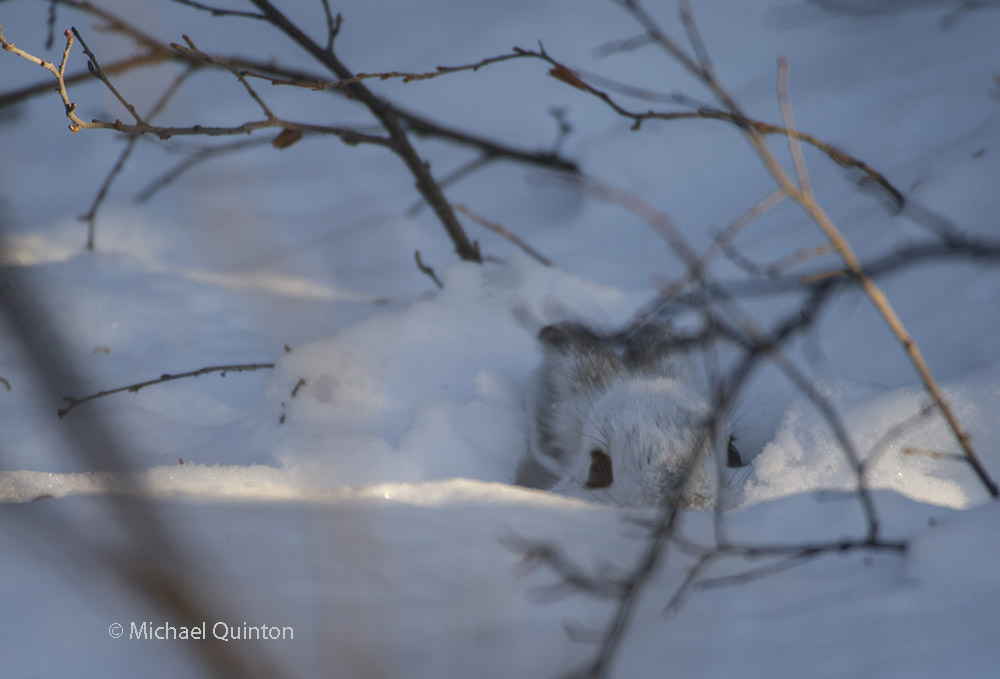 The snowshoe hare has perfected the art of camouflage, but as an extra defense against the goshawks, they often use snow burrows. But the snowshoe hares’ best defense against the sudden attacks by goshawks is its nocturnal behavior.
The snowshoe hare has perfected the art of camouflage, but as an extra defense against the goshawks, they often use snow burrows. But the snowshoe hares’ best defense against the sudden attacks by goshawks is its nocturnal behavior.
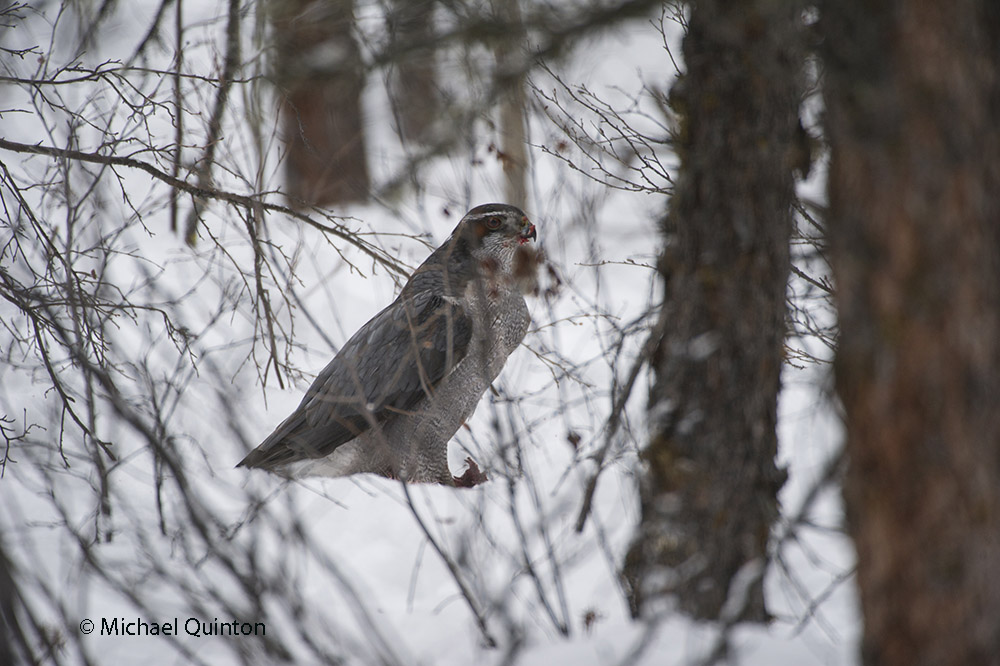 An adult northern goshawk feeds on a snowshoe hare.
An adult northern goshawk feeds on a snowshoe hare.
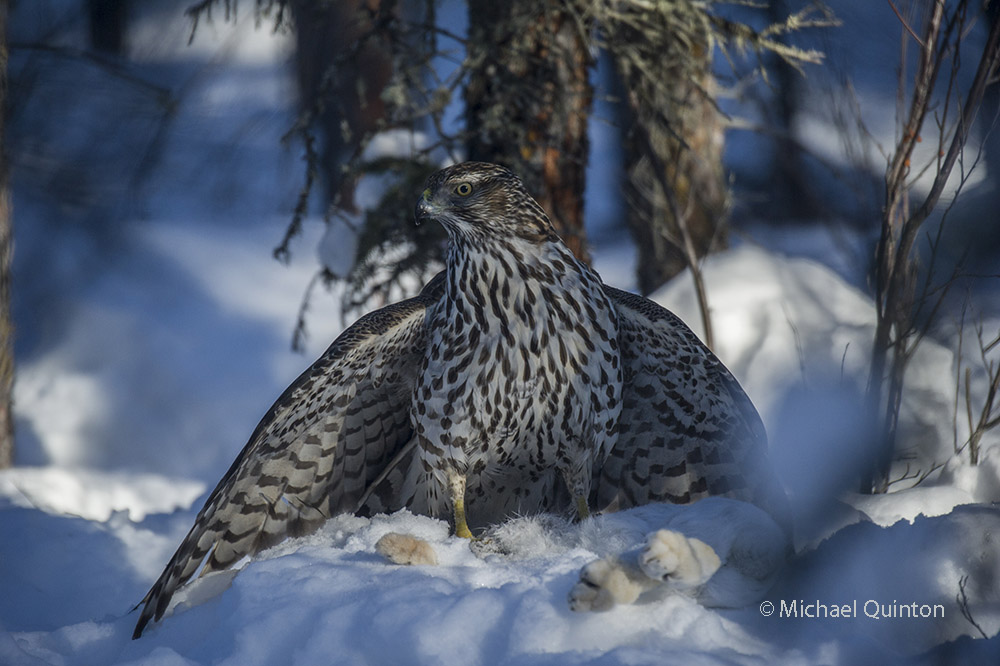 As I photographed a snowshoe hare this immature northern goshawk suddenly appeared out of the blue shadows and killed my photo subject. She mantles her prey with powerful wings.
As I photographed a snowshoe hare this immature northern goshawk suddenly appeared out of the blue shadows and killed my photo subject. She mantles her prey with powerful wings.
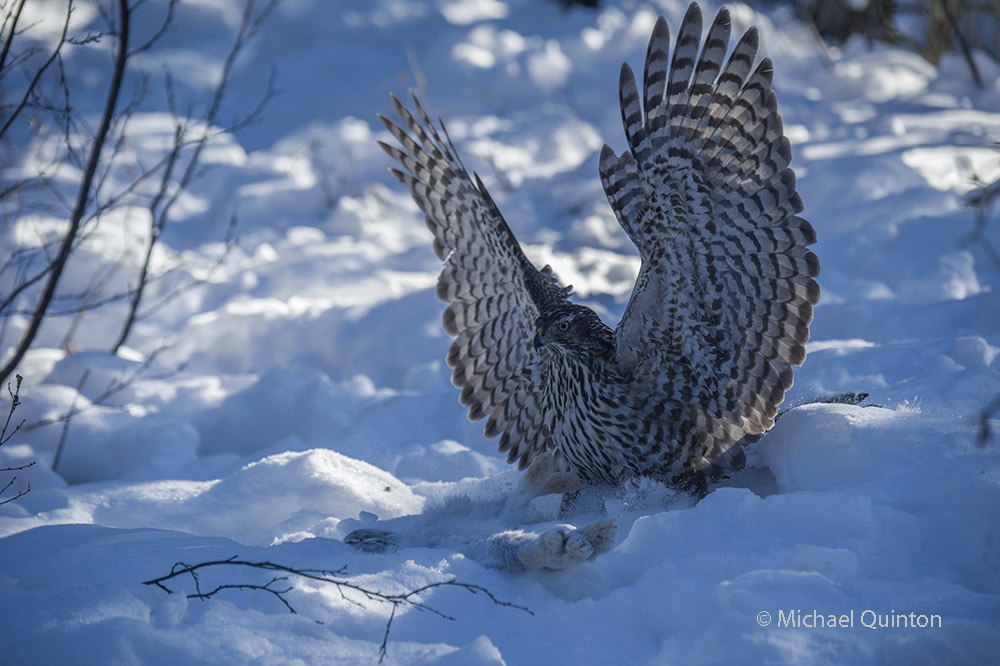 Often northern goshawks show little fear of humans. When I approached it flew a few yards away but quickly returned to its prey. The goshawk fed for nearly an hour leaving only the feet, fur, guts, head and large bones.
Often northern goshawks show little fear of humans. When I approached it flew a few yards away but quickly returned to its prey. The goshawk fed for nearly an hour leaving only the feet, fur, guts, head and large bones.
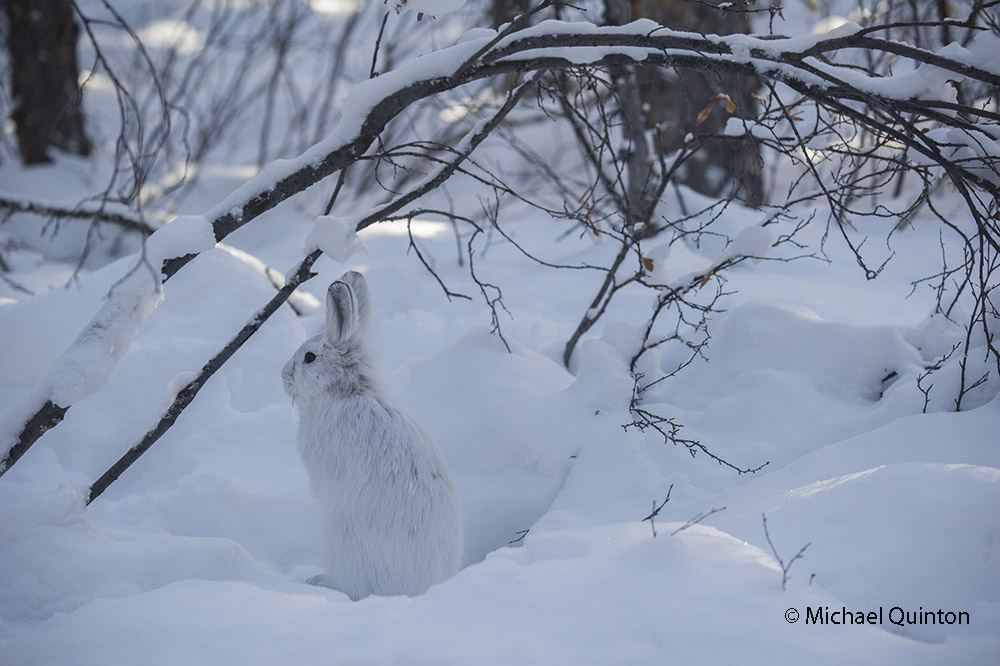 While the snowshoe hare population is near its peak this year, their primary predators populations (northern goshawk, lynx, coyote and great horned owl) are also peaking. And this heavy predation will inevitably cause the next snowshoe hare population crash.
While the snowshoe hare population is near its peak this year, their primary predators populations (northern goshawk, lynx, coyote and great horned owl) are also peaking. And this heavy predation will inevitably cause the next snowshoe hare population crash.
 For months, over two nesting seasons I spent nearly every day in the company of northern goshawks. Slowly they would reveal their secret lives.
For months, over two nesting seasons I spent nearly every day in the company of northern goshawks. Slowly they would reveal their secret lives.
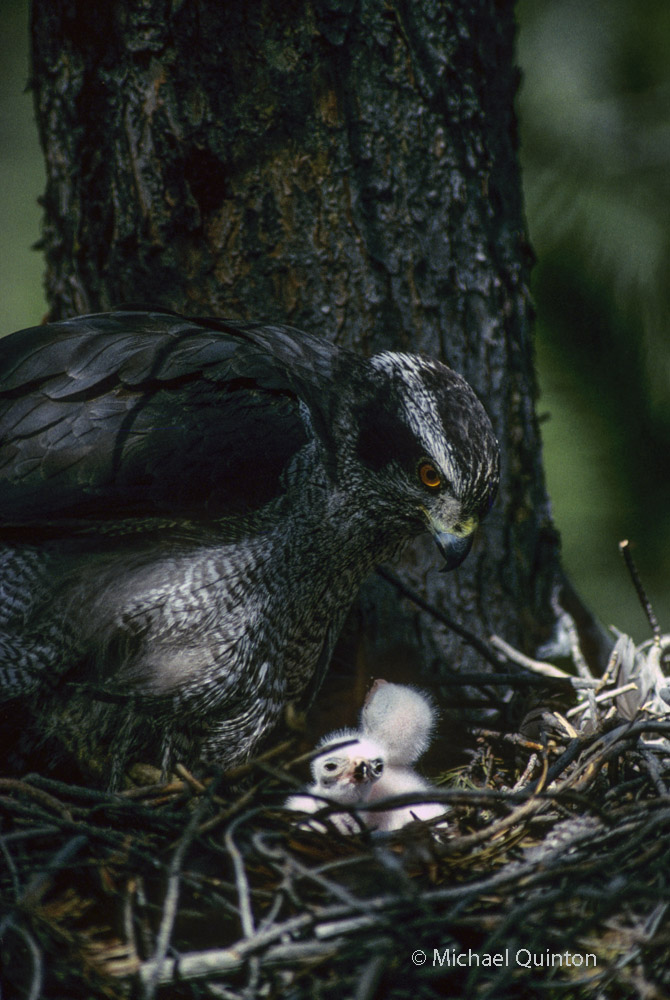 High in the canopy a female tends to her day old chicks.
High in the canopy a female tends to her day old chicks.
After the chicks hatch, northern goshawks become very aggressive at their nests. By visiting the nesting territory on a daily basis, starting early in the nesting season I seemed to have gained the trust of the goshawks. By building my blind near their nest under the cover of darkness, wearing the same clothes everyday and never disturbing the nest, I was able to climb into my photo blind or walk around the forest below unmolested.
The great female goshawk rose up from her eggs and stepped to the edge of her three-foot wide nest. Eyes of blood locked onto her target. Diving headfirst off the nest, she pumped her wings quickly accelerating to attack speed. Long tail feathers flared and pivot, sending the goshawk speeding around the base of a large douglas fir and crashing into the understory. Squealing in terror, a red squirrel jumped to the trunk and instinctively darted to the opposite side, sticking like velcro to the rough, dry bark, then squirrel shot up the trunk into the canopy. Again the goshawk attacked. Going up, the squirrel was faster but on the way back down the goshawk closed the distance.
Among the thick branches of the canopy the squirrel had the edge, but not by much. Using feet, bill and wings, the goshawk literally swam through the boughs. Desperate to lose the hawk, the squirrel spiraled up the nest tree and right over those precious eggs, before jumping to an adjacent tree. The squirrel somehow missed being snagged by those talons, utilizing unearthly tricks of speed and anti-gravity. I could keep track of the chase through the various observation and lens slits cut into the photo blind, but the action was much too quick and hard to follow so I missed getting any photos. It was inevitable I guess, when I felt the squirrel coming up my blind tree, the gos riding his wind. A vision of the squirrel taking refuge up my pant leg was suddenly a painful possibility. Just as the squirrel shot inside the blind I yelled and smacked the side of the blind. Luck was cheap that June morning. After a couple of quick laps around the legs of me and my tripod, the squirrel dashed back out and jumped to the next tree about five feet away.
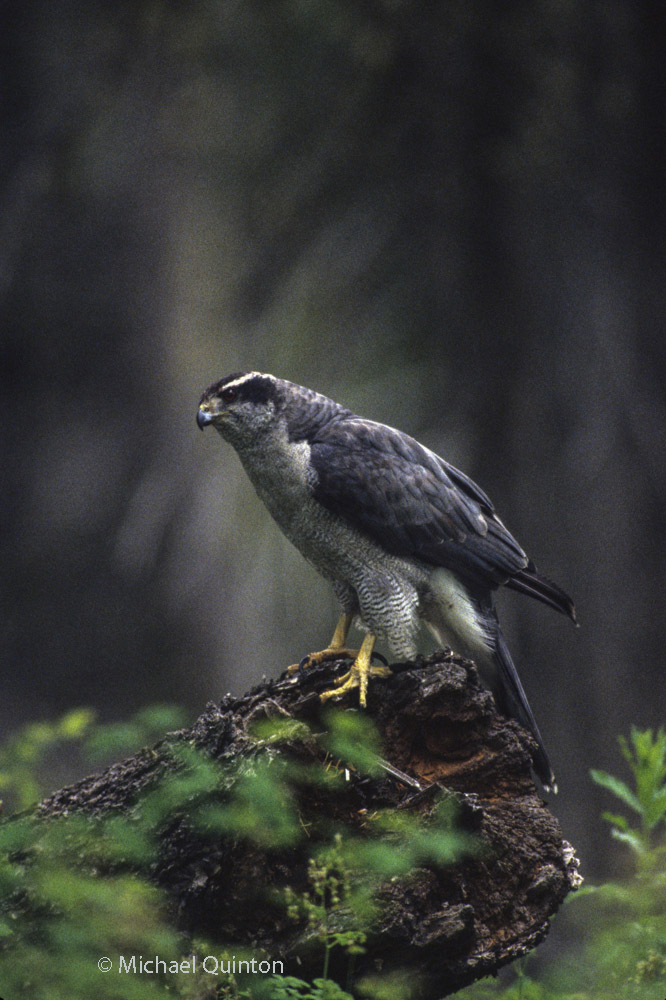 Slamming through the branches with little regard for its plumage, the gos didn’t let up. But the squirrel had a little luck of his own stashed away. Running headfirst down the trunk, the squirrel made an Olympic jump 25 feet from the ground. Bouncing off the forest floor the squirrel made for thicker scenery. After orbiting several more big trees and an amazing sling-shot the squirrel made it to a thick jungle of downfall. For the next 30 minutes, the goshawk perched 20 feet below her nest and preened. The squirrel barked, chattered and buzzed and told the world what he thought of goshawks nesting in his five acres.
Slamming through the branches with little regard for its plumage, the gos didn’t let up. But the squirrel had a little luck of his own stashed away. Running headfirst down the trunk, the squirrel made an Olympic jump 25 feet from the ground. Bouncing off the forest floor the squirrel made for thicker scenery. After orbiting several more big trees and an amazing sling-shot the squirrel made it to a thick jungle of downfall. For the next 30 minutes, the goshawk perched 20 feet below her nest and preened. The squirrel barked, chattered and buzzed and told the world what he thought of goshawks nesting in his five acres.
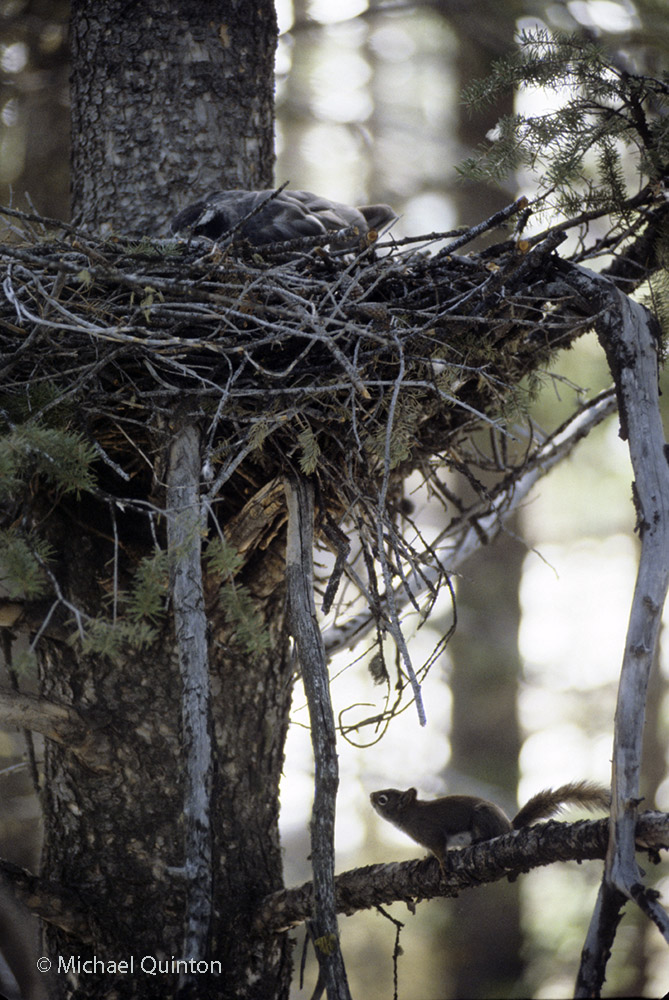 Three weeks earlier, the goshawk had calmly sat on her eggs while this same squirrel climbed the nest tree, dug into the bottom of the nest to find and nibble on mushrooms. I guess it seemed like the perfect place to dry mushrooms.
Three weeks earlier, the goshawk had calmly sat on her eggs while this same squirrel climbed the nest tree, dug into the bottom of the nest to find and nibble on mushrooms. I guess it seemed like the perfect place to dry mushrooms.
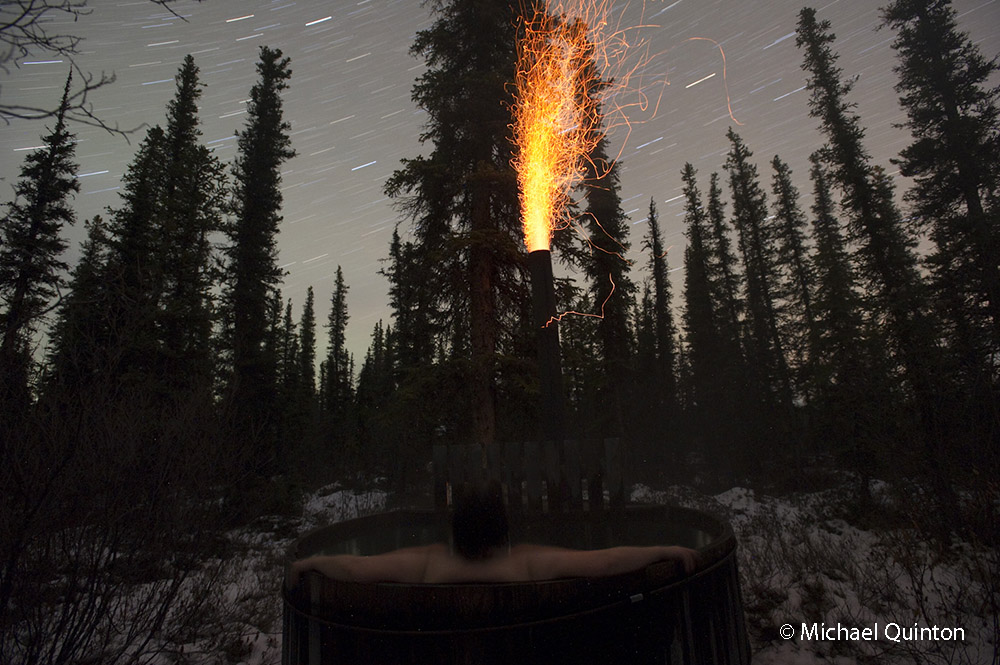 Relaxing in the wood fired Snorkel hot tub.
Relaxing in the wood fired Snorkel hot tub.
After supper, I built a fire in the hot tub. Overnight the temperature had dropped to about fifteen below zero F. and the temperature in the hot tub was down to about seventy degrees F. It takes about two hours to get the hot tub temperature back to one hundred degrees. Cindy and I jumped in and watched the stars and the occasional meteor streak overhead. An hour later we climbed out and got dressed in the nearby sauna, also heated with a wood stove.
I noticed a green glow of aurora borealis in the north and decided to take out a camera. I set the tripod and camera on the ice of Rufus Creek. The camera was set on interval timer to record a photo every ten seconds that I could later turn into a video. Returning to the house I told Cindy the aurora was really going for it so she got dressed for the cold and we went outside. I took along another camera and set it to record the aurora dancing over the house. We watched as the aurora went crazy. But it was getting chilly so I suggested we walk out to the hot tub and check the temp. I slide the lid over and the thermometer read 106 F. A bit on the warm side but tolerable so we stripped down and jumped in. And for the next hour we relaxed in luxury and soaked it all in.
 Aurora borealis dancing over icy Rufus Creek
Aurora borealis dancing over icy Rufus Creek
Below are the videos I made.
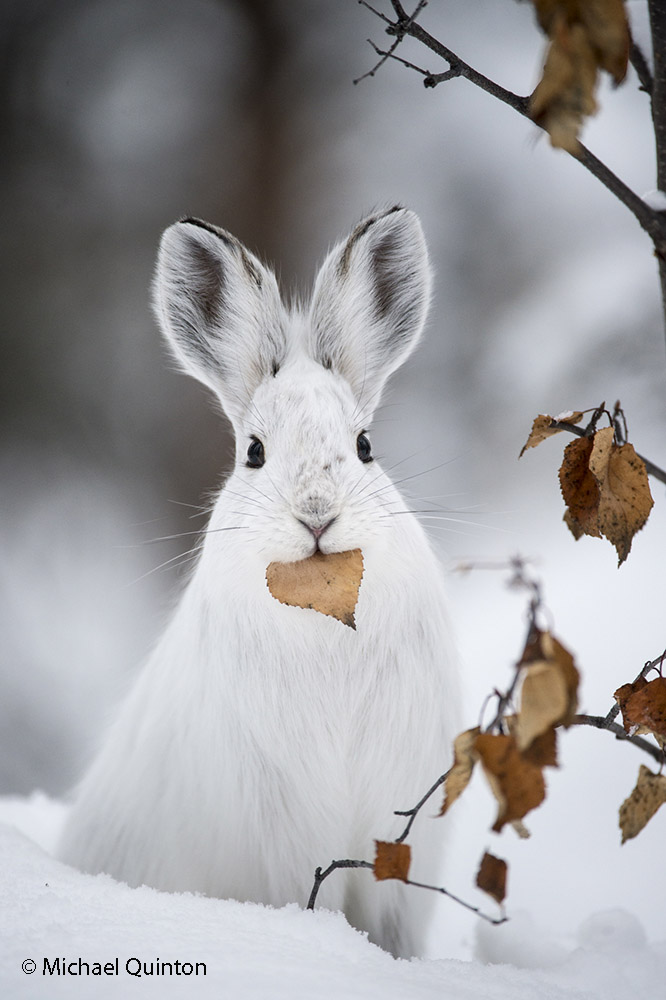 Very few birch still have unshed leaves during the long Alaskan winter and most are just too high for the hares to reach. But this winter extra heavy snows, more than three feet deep in places, brought a limited amount of these prefered leaves within reach of the hares.
Very few birch still have unshed leaves during the long Alaskan winter and most are just too high for the hares to reach. But this winter extra heavy snows, more than three feet deep in places, brought a limited amount of these prefered leaves within reach of the hares.
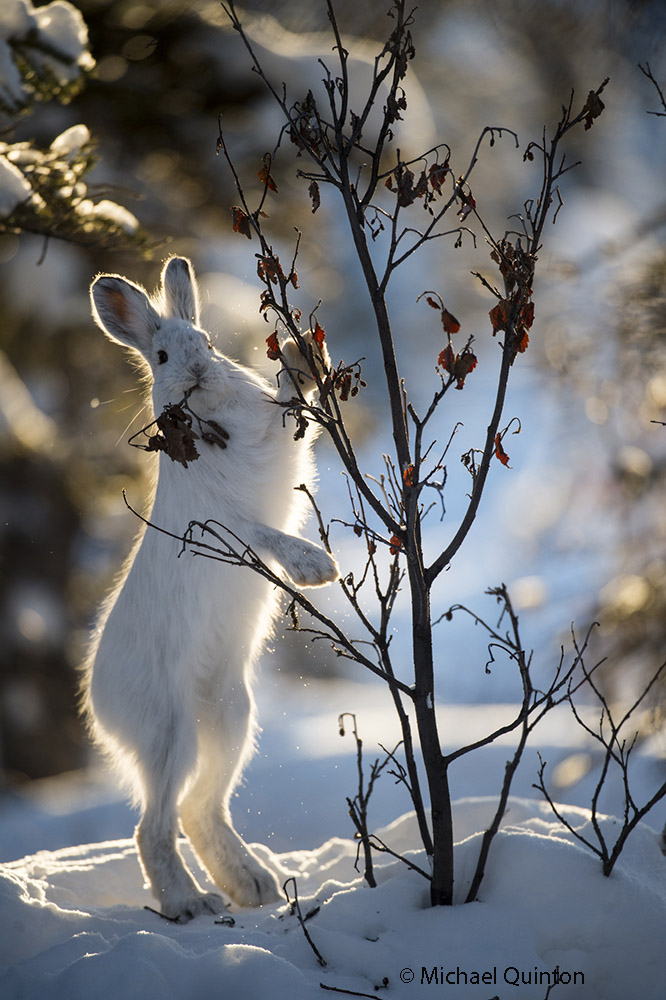 Alder is on a snowshoes “short list” of favorite winter foods. Of course leaves and small branches are prefered.
Alder is on a snowshoes “short list” of favorite winter foods. Of course leaves and small branches are prefered.
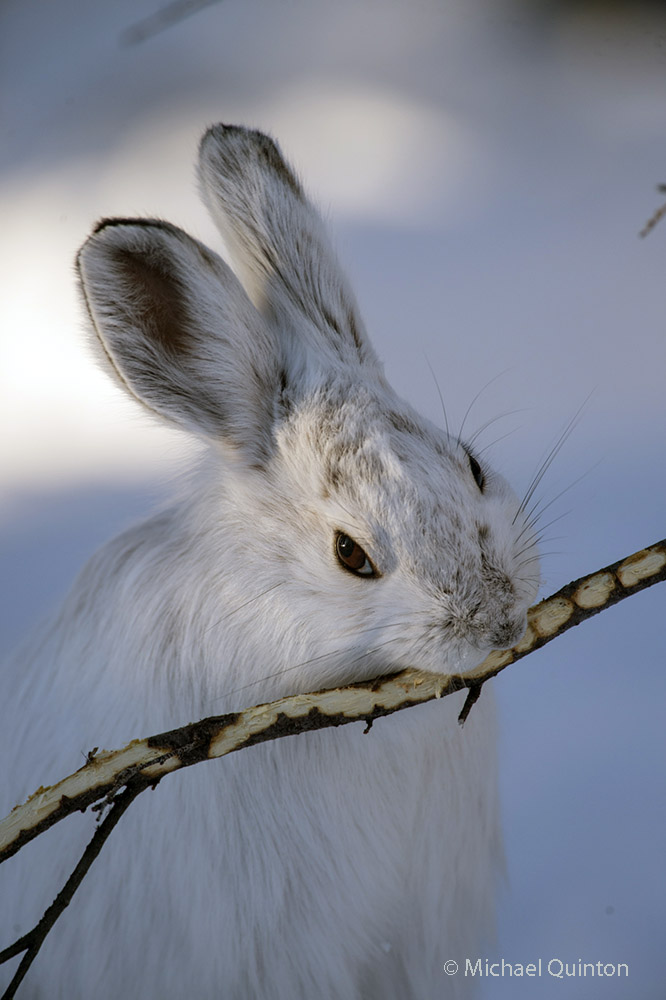 This snowshoe hare feeds on the bark of alpine birch. Hares often dig deep into the snow to reach the small twigs of blueberry. And, the large number of willow species found in these northern boreal forests are another important winter food.
This snowshoe hare feeds on the bark of alpine birch. Hares often dig deep into the snow to reach the small twigs of blueberry. And, the large number of willow species found in these northern boreal forests are another important winter food.
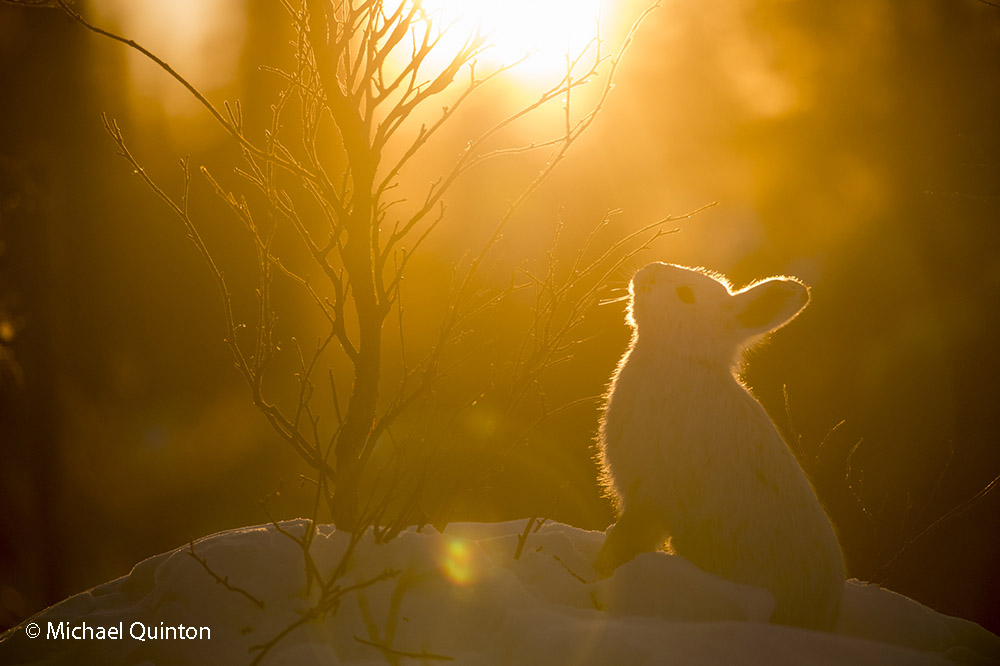 Snowshoe at sunset checks out a birch sapling.
Snowshoe at sunset checks out a birch sapling.
https://www.youtube.com/watch?v=XvzyMyCI59g
Snowshoe hares in winter feeding on dry alder leaves.
https://youtu.be/9ewR7-Rgeis
1850 still photos into a one minute video.
https://youtu.be/ZiuzOzNt80g
Each winter dall sheep migrate to their rugged, windswept slopes. It is here that their dramatic rut takes place.
https://youtu.be/V64iQtqFnzI
I braved the twenty below night temperatures, took 1,159 photos over a four hour period and linked them into a munute long video.
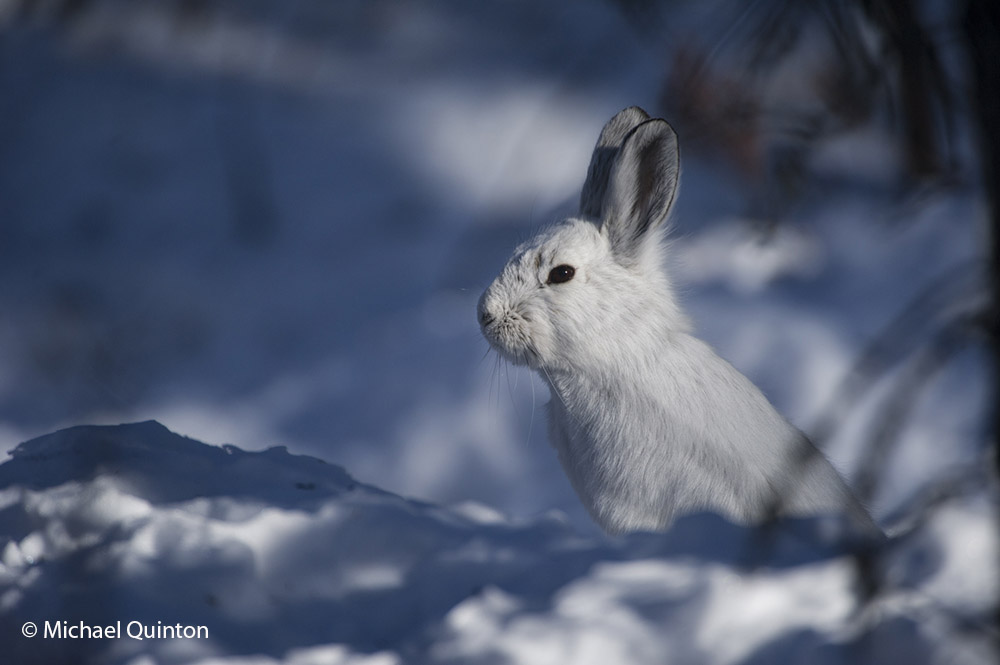 In early March, snowshoe hare (Lepus americanus) tracks began to appear where none had been all winter long. I guess the solitary males are out and about looking for females. The snowshoe hare cycle has been on the upswing for a couple of years but the hares are still uncommon in most of the black spruce forests around our place on the northern edge of Wrangell/St. Elias National Park. High quality hare habitat, mixed forests with willow and alder thickets are the nucleus of hare populations and often the only places where hares are common during low-cycle years . These “bunny patches” are where snowshoe hares multiply and disperse. A rising (or falling) hare population has a big impact on most predators and their prey. With snowshoe hare populations locally low, their main predators, lynx, red fox, northern goshawks, great horned owls and even northern hawk owls are low as well. Low numbers of predators has relieved pressure on prey species such as spruce grouse and snowshoes allowing them to recover. Grouse populations have the ability to rebound rather quickly as we have seen them do locally. All these cycles are driven to a large degree by the rise and fall of snowshoe hares. Continue reading
In early March, snowshoe hare (Lepus americanus) tracks began to appear where none had been all winter long. I guess the solitary males are out and about looking for females. The snowshoe hare cycle has been on the upswing for a couple of years but the hares are still uncommon in most of the black spruce forests around our place on the northern edge of Wrangell/St. Elias National Park. High quality hare habitat, mixed forests with willow and alder thickets are the nucleus of hare populations and often the only places where hares are common during low-cycle years . These “bunny patches” are where snowshoe hares multiply and disperse. A rising (or falling) hare population has a big impact on most predators and their prey. With snowshoe hare populations locally low, their main predators, lynx, red fox, northern goshawks, great horned owls and even northern hawk owls are low as well. Low numbers of predators has relieved pressure on prey species such as spruce grouse and snowshoes allowing them to recover. Grouse populations have the ability to rebound rather quickly as we have seen them do locally. All these cycles are driven to a large degree by the rise and fall of snowshoe hares. Continue reading